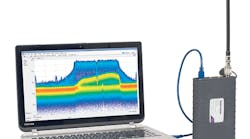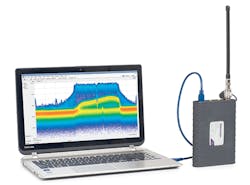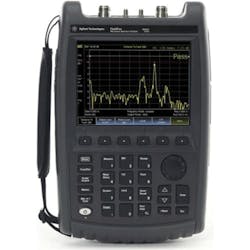This file type includes high resolution graphics and schematics when applicable.
Spectrum analyzers are extremely versatile and useful test instruments that have long been used to study RF/microwave signals. The display screen has often served as a “window on a wireless world,” allowing users to capture and identify different signals within a bandwidth of interest.
Commercial spectrum analyzers are available with many different performance levels, frequency ranges, and operating features. And as with any powerful tool, knowing the essential capabilities of a spectrum analyzer is a good starting point for building the skill needed to benefit from its massive measurement power.
Spectrum analyzers are available in many shapes and sizes, from full-sized rack-mount instruments to more compact, battery-powered, portable analyzers. As this article explains, the instrument architectures can vary as well. Among the options are swept-tuned and real-time spectrum analyzers, providing different techniques for viewing a particular segment of frequency spectrum.
Because they are essentially receivers with a display screen, spectrum analyzers among all RF/microwave test instruments are well suited for on-site measurements, which have encouraged an evolution of “shrinking” spectrum analyzers over the past few decades.
Many may recall the 492/492P and 496/496P series of spectrum analyzers from Tektronix as starting points for RF/microwave spectrum analyzers, since they could be carried with their built-in handles to a remote test site and quickly set up for spectrum measurements to about 26.5 GHz. Although these were battery-powered, portable spectrum analyzers that brought the accuracy and performance levels of larger rack-mount instruments to the field, they are relatively large by today’s standards for portable spectrum analyzers.
Modern portable spectrum analyzers are considerably smaller than the 492/492P and 496/496P analyzers—more typically represented by the model RSA306 real-time spectrum analyzer from Tektronix (Fig. 1). This spectrum analyzer resembles a hand-held portable radio and leverages an additional computer, such as a laptop computer, for processing power and display capabilities.
During the era of the 492/492P and 496/496P series of spectrum analyzers, the compact RSA306 would hardly be recognized as an RF/microwave test instrument, but it is quite capable of highly accurate spectrum measurements from 9 kHz to 6.2 GHz. Similarly, the FieldFox portable analyzers (Fig. 2) developed by Agilent Technologies (now Keysight Technologies) provided clear views of captured signals over a large screen, with simple-to-use controls underneath.
Spectrum analyzers show signals in the frequency domain (with signal amplitude levels displayed as a function of frequency), in contrast to an oscilloscope (which displays signals in the time domain, with signal levels shown as a function of time. Spectrum analyzers are typically used to track signal activity across a portion of spectrum; they can be used to measure signal frequency and power, but will typically not be as accurate as a frequency counter for measuring frequency or a power meter for measuring power.
A spectrum analyzer is useful for following signal behavior in a given bandwidth, and can follow other signals that may be related to the main signal of interest, such as signal harmonics and spurious content. Spectrum analyzers are excellent tools for tracking noise within a bandwidth of interest, as well as signal interference that may exist within a communications channel.
To be effective, a spectrum analyzer should have the frequency range to cover an application or group of target applications. In a conventional spectrum analyzer, it should have the swept measurement range to cover a suitable bandwidth (such as 50 or 100 MHz) within the total frequency range (such as 10 MHz to 6 GHz). The resolution bandwidth of the spectrum analyzer defines how finely a captured signal can be viewed, such as a 1-Hz resolution bandwidth to display a signal center frequency.
In a real-time spectrum analyzer, the real-time bandwidth is the instantaneous measurement bandwidth of the instrument, which can be tuned across a wider total bandwidth of interest for capturing and studying different signals. It enables an instrument to show all signal activity within that bandwidth at the same time, for a relatively short capture time, which is typically related to the amount of digital memory within the instrument for storing the digitized versions of the captured signal bandwidth.
Spectrum analyzers can also be compared for their amplitude capabilities, with displays typically adjustable for different dynamic ranges, or the minimum to maximum levels of amplitude that can be displayed at one time. The minimum level defines the sensitivity of the analyzer, while the maximum level is usually just below the damage level.
One of the more important amplitude-related specifications for a spectrum analyzer is the maximum input signal level that can be accepted to an instrument without causing damage. Amplitude specifications also include the maximum signal level at which an instrument will meet its specifications, and the amplitude accuracy of the spectrum analyzer at all displayed center frequencies.
Both benchtop and portable spectrum analyzers may be designed for use with an external frequency reference source in addition to their built-in frequency reference source, when increased levels of amplitude and frequency accuracy may be required. The frequency reference accuracy of a built-in reference is usually defined to meet a certain value after a certain warmup period.
The internal reference is also characterized in terms of aging rate, in ppm, usually defined for the first year and then for each consecutive year. Spectrum analyzers may also define an input frequency or frequency range and amplitude level range for an external frequency reference, to simplify connections when using a spectrum analyzer with an external frequency reference.
This file type includes high resolution graphics and schematics when applicable.



